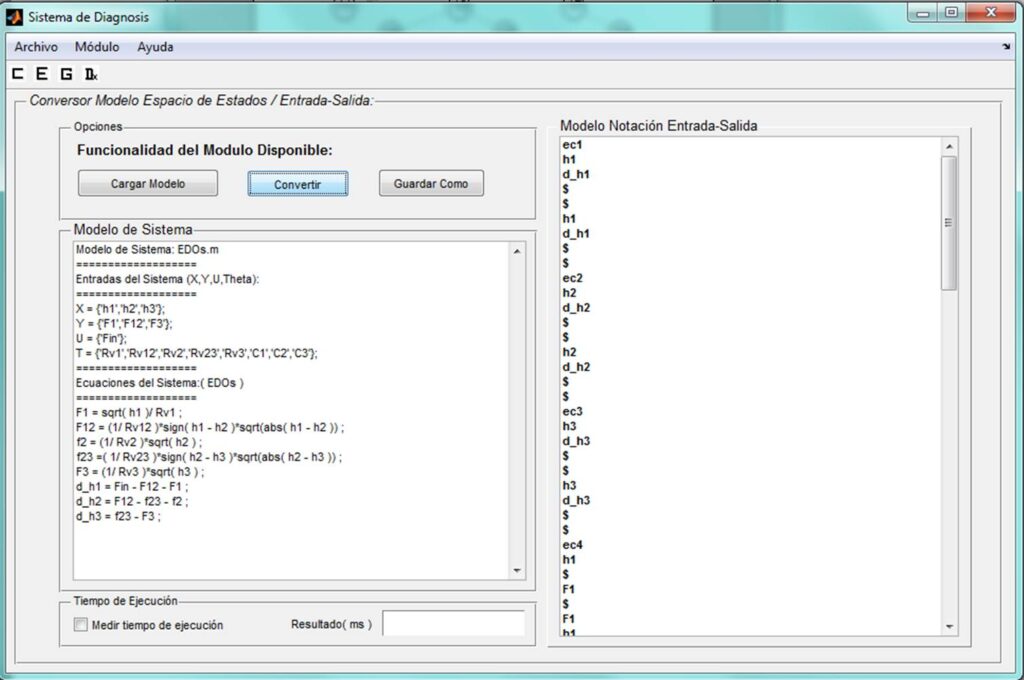Tools for Computing the Set of Possible Conflicts (developed by Group of Intelligent Systems, UVa)
1. Tool for computing the set of Possible Conflicts given a simplified I/O model
File: <Setup_PCs4.0.exe> (Windows application installer (created with Inno Setup))
To use the tool, just install in your system, following the by-default options.
Once the tool is installed, run the application (PCs 2.0). For non-Spanish users, first option is to go to the Opciones Tab and select Idioma (Language), and select Ingles. Afterwards, you will have the English interface.
– Select the option: Load System. While you get familiar with the compact syntax of the input file, you can use one example file from the Folder: Sistemas txt. The classical polybox example (from 1982 classical Davis article and also used by (de Kleer and Williams, 1987) to illustrate GDE performance) or the also classical full-adder can be two very good initial samples: ent_multicaja.txt and sumador-completo.txt.
A more detailed description of the system can be found in the XML version of these files: sumador_multiplicador.xml and sumador_completo.xml, respectively.
Once you get the file in the left hand side of the interface, you just need to select an algorithm: Algorithms / Load Algorithm, and select one from the set of available versions of PC computation:
- CPC Valladolid performs the basic Possible Conflict calculation, for static systems. There is no fault or dynamic model information.
- CPC Valladolid con Ciclos needs a detailed xml file as input, where dynamic information can be provided for each equation in the model, just providing the label integral or derivative for the kind of causality required to solve differential equations. The system is capable to detect and solve cycles made up only of algebraic constraints, to detect and ignore cycles containing differential constraints in integral causality, and to detect and reject cycles containing differential constraints in derivative causality.
- CPC Valladolid con condiciones extends these previous versions including constraints for each relation/equation, i.e. it is capable to model hybrid systems whose operation modes can be described by this type of constraints. These constraints are given in terms of observed variables, and can be true or false. The set of PCs are computed taking into account that a Minimal Evaluable Model can not contain two conflicting constraints.
– To obtain the set of PCs, you just need to press the Compute PCs or Green Arrow symbol or just follow the sequence of intermediate steps: Calculate MECs, Calculate MEMs, and Calculate PCs/Save.
Once you save as an XML file, the result can be visualized.
File: <PCC-4.0 Setup.exe> (A beta version with a larger set of algorithms for computing PCs is available)
- Improved version of CPC Valladolid with ciclos, allowing to automatically introduce information about differential constraints in the model by adding the text d/dt with the name of the constraint. For instance, equation ec6 d/dt
- Fault Signature Matrix and Fault Isolability analysis using PCs. Those equations containing faults must have the name ec<x>_<faulty parameter> where <x> is the number of equation, and <fault parameter> is the name of the parameter affected by the fault. For instance, ec7_R3
- Information about constraints in the equations can be obtained adding #<test> or #!<test> after the specification of the equation or the causal interpretation to represent that <test> must be true or false, respectively. For instance, the following text represent two causal interpretations for the equations:

![]()
ec7_R2
q
h
$
$
q
h
#sw1
$
q
$
$
A small example of how to generate your own input model (in abstract I/O form)
2. Tool for performing Consistency-based diagnosis with Possible Conflicts
File: DBCwPCsv2.zip (requires Matlab; a MVC version will be available soon )
You must download the file, then un-compress the content, and enter Matlab.
You must select the folder Logica de Negocio as part of the path, together with all its sub-folders. Once you must run, using Matlab, the file Sistema_Diagnosis.m
The interface of the system is as follows:

The software has four main capabilities:
– (C tab, for Conversor) to transform a system description as a set of ODEs, together with a description of the input, U, output, Y, state, X, variables and parameters Q: into a input/output model suitable for PCs computation
– (G tab, for generation of computational models): Transform the output file in the PCs computation, text, into a set of ODE models corresponding to one MEM for each PC found. There two options for generating the output model: pure simulation or observational/transitional model for particle filter generation (equivalent to f_i(), and g_i(), for a state-observer, except for the gain term).
1st Cargar Modelo (Load Model description)
2nd Generar (Simulacion) (Generate simulation (.m) model)
3rd Generar (DBN) (Generate DBN (.m) model: generates both a transitional file (with the state space equation from ODEs), and the observational file (with the observational model)
– (E tab) To generate simulation experiment with nominal and faulty behavior for the system model made of ODEs.
– (Dx tab) To generate diagnosis experiments using PCs as simulation or filter models.
Each functionality will ask for several files as inputs:
– Select System Model (EDOs): select for instance EDOs.m (http://www.infor.uva.es/~belar/SoftwareCPCs/EDOs.m)
– Select Input Variables (X, Y, U, Theta): select for instance variables.txt ((http://www.infor.uva.es/~belar/SoftwareCPCs/variables.txt))
– Select CPC file (output of the tool PCs3.0): select for instance ModeloCPC.txt (http://www.infor.uva.es/~belar/SoftwareCPCs/ModeloCPC.txt)
